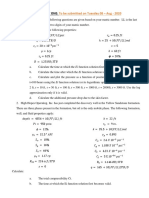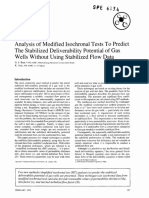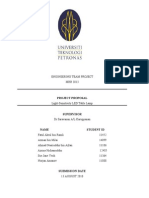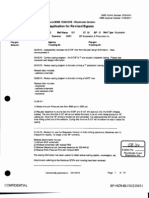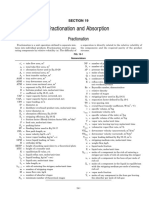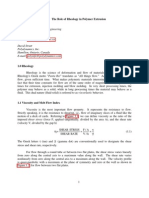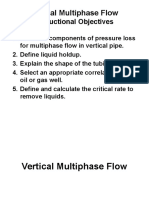Drilll
Drilll
Uploaded by
janethpdllCopyright:
Available Formats
Drilll
Drilll
Uploaded by
janethpdllOriginal Title
Copyright
Available Formats
Share this document
Did you find this document useful?
Is this content inappropriate?
Copyright:
Available Formats
Drilll
Drilll
Uploaded by
janethpdllCopyright:
Available Formats
OCEAN DRILLING PROGRAM
w w w. o c e a n d r i l l i n g . o r g
Scientic Application
The drill string is composed of knobbies, drill pipe, a bottomhole assembly (see the BHA tool sheet), and a bit (see the Core Bit tool sheet). It is used to deploy and retrieve (i.e., run and pull) all of ODPs coring/drilling BHAs, reentry structures, completion hardware, and associated equipment. A drill string undergoes higher tensile, bending, and torque stresses than standard pipe; thus, the tool joints have shoulders that provide stiffness to prevent bending and breaking. The drill string can be run to a maximum coring/drilling depth of ~8375 m in moderate weather (at 6 roll with 100,000 lb overpull and a typical BHA). All drill string elements have a 4.125 in. (10.47 cm) minimum internal diameter (ID) throughout to allow other tools to pass through; therefore, the drill string is compatible with the ODP coring systems, water samplers, temperature/pressure probes, and logging tools. This compatibility reduces pipe trips and maximizes the time spent drilling a hole or recovering core to achieve the science objectives.
Box connection
Shoulder Threads Thread relief Bore ID Tong area Taper
Tool joint OD
Tube
Pin connection
Taper
Tong area
Shoulder Threads
on bottom to reduce the weight and stronger 5 in. OD drill pipe on top where bending stresses are higher. The drill string is run using a dual elevator system, which uses two heavy lift elevators to support the pipe tool joint rather than tooth-type dies in slips. The individual drill pipe joints are manufactured in nominal 31.6 ft (9.65 m) lengths; however, the pipe is handled on the ship in three-joint stands (or triples) for speed in running, pulling, and storing the pipe (Fig. 2). Short lengths of drill pipe called pup joints are available in 5, 10, and 15 ft lengths to adjust (i.e., spaceout) the drill string length, where required, for spudding a hole, landing heavy equipment, or running underreamers inside casing. Two drill strings are maintained on the ship: (a) a ~6900 m working string in the horizontal pipe racker and (b) a ~5000 m backup string in storage in the ships riser hold. The drill strings in use on the JOIDES Resolution are inspected and refurbished (i.e., thread repairs and recoating) every 1 to 2 years. In addition, two backup strings are available onshore: (a) a ~6900 m working string and (b) one 3000 m emergency Condition 2 (i.e., the remaining tube thickness is 70% to 80% of the original specication) backup string maintained onshore in storage.
5 in. FH tool joint connections
Figure 1. Schematic of the box and pin ends of a joint of pipe. The tube section is cut away to shorten the drawing. ID = internal diameter, OD = outside diameter, FH = full note.
Tool Operation
The drill string is supported by the top drive (in the derrick), which
rotates the drill string at the surface to drive the bit and allow the drill string to advance downhole. The drill string is tapered to maximize strength and hanging length by using lighter 5 in. outside diameter (OD) drill pipe (Fig. 1)
Knobbies are heavy-wall pipe with tool joint-sized knobs to reduce the bending stresses as the pipe moves through the curved guide horn and exits the bottom of the ship when tripping pipe. Knobbies are run between the top drive and 5 in. drill pipe (i.e., at the top of the drill pipe). As the hole is deepened, the knobbies are removed by the rig crew and replaced with 5 in. pipe as required by depth and weather. In exceptionally rough weather, aluminum wear knots can be added to the upper portion of the 5 in. drill pipe to reduce bending stresses in the guide horn.
Racker crane
Design Features
1) Large Internal Diameter/ Compatibility All the elements in the drill string have a 4.125 in. (10.47 cm) opening throughout. Benet: The drill string is compatible with all the ODP coring systems, water samplers, temperature/pressure probes, and logging tools. In addition, pumping pressure losses in long drill strings are reduced, thereby, improving hydraulics for hole cleaning. 2) High Strength Pipe The drill string is made of high tensile strength S-140 steel, which is more brittle than typical drill pipe but stronger, with a tensile strength of 140,000 psi. There are many types of drill pipe, but typical drill pipe has a strength of ~95,000 psi. The strength benets of the S-140 pipe outweigh the increased brittleness, but the brit-
Racker handling arms
Drill pipe stand
Skate slide
Figure 2. Photo shows a stand of drill pipe and the skate slide the stand sits in before it is made up to the drill string. The photo is looking toward the back of the ship and shows a portion of the racker crane (left), which moves pipe to and from the horizontal racker and riser hold storage.
tleness requires special handling. It is essential to avoid notch damage (stress concentration points) (see Design Feature 4). ODP acquired S-135 pipe early in the program, and that is used in the backup drill string (135,000 psi tensile strength). Benet: The stronger pipe can support heavier hanging loads for longer drill strings, run heavier casing strings and reentry installations and equipment, and
provide more overpull force to free struck pipe. 3) Triple Lengths The drill pipe joints are made in 31.6 ft (9.6 m) lengths and are run and stored horizontally on the ship in three-joint sections known as triples or stands (Fig. 3). Benet: Increases the speed in running, pulling, and handling the pipe and reduces wear to the pipe tool-joint threads. Typical running speeds are ~700 m/
Benet: The shouldered tool joints prevent bending and breaking. The threaded connections are in heavy tension and are made up with high torque to prevent the pipe from unscrewing during use. 7) Pipe Inspection Current protocol calls for the pipe to be inspected every 1 to 2 years using nondestructive electromagnetic induction (EMI) or ultrasound inspection techniques. Benet: The pipe inspection helps to identify defects in pipe joints to avoid catastrophic failures that could lead to loss of the drill string. Condition 1 pipe has at least 80% remaining wall thickness and is reconditioned if possible. Condition 2 pipe has 80% to 70% remaining wall thickness and is stored for an emergency backup string if it meets tool joint length criteria (i.e., there is enough length in the tool joint to be gripped by power tong jaws).
Figure 3. Drill pipe stands are stored in the horizontal pipe racker, which is located behind the derrick and rig oor.
hr and typical pulling speeds are ~550 m/hr, depending on weather and string length and weight. 4) Dual Elevator System The drill string is run using a dual elevator system, which uses two elevators (or lift collars) to support the pipe tool joint rather than toothed friction-type slips that could notch and create stress concentration (weak) points in the tube of the high-strength drill pipe (Fig. 4). Benet: Elevators provide a positive and stronger support under the tool joint than a slip, and reduce notch damage to the pipe tube; thus, the pipe can be used longer. 5) Coating The drill pipe is coated inside and outside with an inorganic zinc anticorrosion compound.
Benet: The internal coating reduces the formation of rust, which can act as a contaminant during coring, and the coating reduces saltwater corrosion pitting (i.e., a reduction in tube wall thickness), which can degrade strength during horizontal storage. Rust can hamper thread makeup and handling; thus, an external coating is applied to reduce rust. 6) Threaded Connections The drill pipe has threaded connections, which are rotary shouldered tool joints designed for rotation in the open ocean (i.e., without a constraining riser). The 5 in. drill pipe has 5 in. full hole (FH) tool joints (7 in. OD), and the 5 in. drill pipe has 5 in. internal ush (IF) tool joints (7 in. OD). The 5 in. FH connections in the drill string have been enlarged to a 4.125 in. (10.47 cm) ID.
Drill String Specications
For drill pipe tube and pipe strength specications, see Table 1. For drill pipe tool joint specications see Table 2. Drill Pipe Joint Length: 31.6 ft (9.6 m) Minimum Internal Diameter: 4.125 in. (10.47 cm) Minimum Tensile Strength: 140,000 psi
Table 1. Drill pipe tube and pipe strength specications. Cond. 1 Pipe 80% Tensile Strength (lb) 590,754 879,645
Drill Pipe Tube OD (in.) 5 5
Drill Pipe Tube ID (in.) 4.276 4.500
Nominal Weight Tube (lb/ft) 19.50 26.67
Adjusted Overall Joint Weight (lb/ft) 22.1 31.9
API Steel Grade S-140 S-140
100% Tensile Strength (lb) 738,443 1,099,557
Note: Cond. = condition, API = American Petroleum Institute Table 2. Drill pipe tool joint specications. Drill Pipe Tube OD (in.) 5 5 API Tool Joint Threads (in.) 5 Full Hole 5 Internal Flush Tool Joint OD (in.) 7.00 7 Tool Joint ID (in.) 4-1/8 *
(*bored to 4-1/8)
Tool Joint Makeup Torque (ft/lb) 28,000
Burst Strength (psi) 10,000
Collapse Strength (psi) 5,000
4-1/8
48,000
10,000
5,000
Note: OD = outside diameter, API = American Petroleum Institute, ID = internal diameter.
Typical Operating Range
Depth Range: 8375 m Typical Drill String Conguration: BHA with crossover to ~3500 m of 5 in. drill pipe, 5 5 in. drill pipe crossovers, and 5 in. drill pipe as required for total length. Knobby joints are added as required below the top drive and replaced with drill pipe as required.
Limitations
The depth limit of a tapered 5 in. 5 in. S-140 drill string is ~ 8375 m in moderate weather (at 6 roll with 100,000 lb overpull). The minimum ID through the drill string is 4.125 in. (10.47 cm). The Advanced Piston Corer/Extended Core Barrel (APC/XCB) BHA has a 3.75 in. ID restriction in the seat-
Figure 4. Making a drill pipe connection on the rig oor. The elevator (red clamp at the bottom of the picture) supports the box [or upper] end of the drill pipe and holds the weight of the entire drill string during a connection.
ing nipple and the APC/XCB bit ID is 3.80 in. Therefore, the APC/XCB shoes and instruments that pass through the drill string, seating nipple, and bit must have an OD less than 3.75 in.
You might also like
- Assignment 1Document2 pagesAssignment 1Dexter TanabeNo ratings yet
- Analysis of Modified Isochronal Tests To Predict The Stabilized Deliverability Potential of Gas Wells Without Using Stabilized Flow DataDocument19 pagesAnalysis of Modified Isochronal Tests To Predict The Stabilized Deliverability Potential of Gas Wells Without Using Stabilized Flow DataAndreco 210198No ratings yet
- John Kevin M. de Castro 16000494: Assignment in Production Technology - MSC in Petroleum EngineeringDocument8 pagesJohn Kevin M. de Castro 16000494: Assignment in Production Technology - MSC in Petroleum EngineeringAileen AradaNo ratings yet
- Final Proposal Etp ExampleDocument11 pagesFinal Proposal Etp ExampleAfif IzwanNo ratings yet
- ENPE 515 W 2013 Assignment 3.313Document2 pagesENPE 515 W 2013 Assignment 3.313ench501No ratings yet
- Recombination and Properties of Wet GasesDocument26 pagesRecombination and Properties of Wet GasesLawrenceLopezNo ratings yet
- PTRT 2323assignments 9-10 PDFDocument1 pagePTRT 2323assignments 9-10 PDFAlmotsem0% (1)
- Petrowiki Pressure Drop EquationsDocument14 pagesPetrowiki Pressure Drop Equationsrasnowmah2012No ratings yet
- SPE 04629 Fetkovich Decline TCDocument28 pagesSPE 04629 Fetkovich Decline TCjoseNo ratings yet
- Application For Revised Bypass: Form MMS l23A/t23S - ElectronicDocument10 pagesApplication For Revised Bypass: Form MMS l23A/t23S - ElectronicOSDocs2012No ratings yet
- Koya University: Gel StrengthDocument9 pagesKoya University: Gel StrengthibrahimNo ratings yet
- RigsPresentation PDFDocument16 pagesRigsPresentation PDFAndrei ClaudYuNo ratings yet
- How To Read Boring LogsDocument3 pagesHow To Read Boring LogsDianna LambertNo ratings yet
- Well Test Analysis (PETE 4225) Midterm Examination (Open Notes) Date: Thursday, October 15, 2020 Duration: 2 Hours (3:00 PM - 5:00 PM)Document8 pagesWell Test Analysis (PETE 4225) Midterm Examination (Open Notes) Date: Thursday, October 15, 2020 Duration: 2 Hours (3:00 PM - 5:00 PM)Saqib IrshadNo ratings yet
- 5 ProductionDocument16 pages5 ProductionUthman MohammedNo ratings yet
- Lab ManuelDocument79 pagesLab ManuelMarty SmurdaNo ratings yet
- Re Seng CoversDocument19 pagesRe Seng CoversweldsvNo ratings yet
- Economic Comparation Between SRP and PCP Pump at Syrian FieldDocument20 pagesEconomic Comparation Between SRP and PCP Pump at Syrian FieldBram ANo ratings yet
- Petroleum EngineeringDocument101 pagesPetroleum Engineeringcarlos801No ratings yet
- Taller 1Document5 pagesTaller 1José Fernando TerronesNo ratings yet
- ZXXXXDocument12 pagesZXXXXMikael MarkovNo ratings yet
- (WellDeliverabilty) BottomHoleNodal-Gas WellDocument8 pages(WellDeliverabilty) BottomHoleNodal-Gas Wellyimam aliNo ratings yet
- Directional Drillingjuly08Document23 pagesDirectional Drillingjuly08ANISAHNo ratings yet
- Spe 31656 MS PDFDocument99 pagesSpe 31656 MS PDFVíctor Eduardo Salas OlguínNo ratings yet
- M19Document36 pagesM19karenNo ratings yet
- مادة التحليلات الهندسيهDocument61 pagesمادة التحليلات الهندسيهحسن صالح حسن المياحيNo ratings yet
- Lecture02 Pipeflow HandoutDocument3 pagesLecture02 Pipeflow HandoutAdjei BaldanNo ratings yet
- Exercise 2: Determine The Value of U So That There Will Be No Deposit of ParaffinDocument2 pagesExercise 2: Determine The Value of U So That There Will Be No Deposit of ParaffinHan Thinh NguyenNo ratings yet
- Dogleg Reamer in Oil Well DrillingDocument12 pagesDogleg Reamer in Oil Well DrillingNguyen Van HieuNo ratings yet
- Well Survey MethodDocument44 pagesWell Survey MethodSHUBHAM SINGHNo ratings yet
- Rise Velocity Gas BubbleDocument20 pagesRise Velocity Gas Bubbleabolore2012100% (1)
- 3.1 Production Mechanisms EXERCISES QuestionsDocument19 pages3.1 Production Mechanisms EXERCISES Questionsgilberto monteiroNo ratings yet
- Red Book Section 130Document10 pagesRed Book Section 130Alejandro ViscarraNo ratings yet
- Air Compressors 1170cfm T4Document2 pagesAir Compressors 1170cfm T4death666darkNo ratings yet
- Presented By: Kaushik Phukan Jyotishman Dutta Pitagoras SoaresDocument44 pagesPresented By: Kaushik Phukan Jyotishman Dutta Pitagoras SoaresPITAGORAS MANUEL MARTINS SOARESNo ratings yet
- Tugas 2 PetrofisikDocument5 pagesTugas 2 PetrofisikAldian0% (1)
- IIT (ISM) SyllabusDocument34 pagesIIT (ISM) SyllabusSaurav SenguptaNo ratings yet
- Applied Homework 1Document5 pagesApplied Homework 1Roba SaidNo ratings yet
- Exercises On Fluid Flow in HC ReservoirsDocument3 pagesExercises On Fluid Flow in HC ReservoirsMohamed SahnounNo ratings yet
- Types of CompletionDocument8 pagesTypes of CompletionAshrafNo ratings yet
- Intro OCTGDocument83 pagesIntro OCTGnader gholipourNo ratings yet
- Exercise 2Document3 pagesExercise 2mehmet candanNo ratings yet
- Assignment 1Document3 pagesAssignment 1andresNo ratings yet
- Applications of ResonanceDocument4 pagesApplications of ResonancesrinupidNo ratings yet
- Role of Rheology in ExtrusionDocument25 pagesRole of Rheology in Extrusionchristopher_kephart1No ratings yet
- Briefing N°12 - Joshi S-Method - Calculation-of-Critical-Flow-Rate - Horizontal-WellsDocument3 pagesBriefing N°12 - Joshi S-Method - Calculation-of-Critical-Flow-Rate - Horizontal-WellsANDREW LOJANo ratings yet
- Rock PermeabilityDocument43 pagesRock PermeabilityShaho Abdulqader Mohamedali100% (1)
- Pnaaw239 PDFDocument165 pagesPnaaw239 PDFSamErnesto007No ratings yet
- 7in N80 Hunting Seal Lock HC DatasheetDocument2 pages7in N80 Hunting Seal Lock HC DatasheetSanjenbam SumitNo ratings yet
- Vertical Multiphase Flow: Instructional ObjectivesDocument23 pagesVertical Multiphase Flow: Instructional ObjectivesIksan Adityo MulyoNo ratings yet
- Chap5 RW Lecturenotes PDFDocument25 pagesChap5 RW Lecturenotes PDFtahermohNo ratings yet
- Horizontal Barriers For Controlling Water ConingDocument8 pagesHorizontal Barriers For Controlling Water ConingBahman MatouriNo ratings yet
- Fractional Flow (Cut-Off SW)Document12 pagesFractional Flow (Cut-Off SW)aNo ratings yet
- NLT Noise ToolDocument2 pagesNLT Noise ToolSubh verma100% (1)
- Lab 5-Measurement of Gel Strength of Drilling Mud by Viscometer.Document15 pagesLab 5-Measurement of Gel Strength of Drilling Mud by Viscometer.Sunny BbaNo ratings yet
- Casing WellDocument26 pagesCasing Wellزين العابدين هيثم لفته جابر100% (1)
- Procedures For Drill String Design Engineering EssayDocument16 pagesProcedures For Drill String Design Engineering EssayGerardy Cantuta AruniNo ratings yet
- University of ZakhoDocument4 pagesUniversity of ZakhoNasih AhmadNo ratings yet
- Driil StringDocument38 pagesDriil Stringsuresh_501No ratings yet
